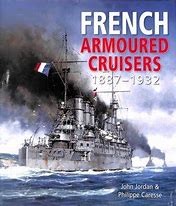
French Armoured Cruisers 1887-1932. John Jordan and Philippe Caresse. Seaforth Publishing, Barnsley, 2019.
Reviewed by Tim Coyle
French design – in fashion, jewellery, architecture, ships, cars or aircraft – is generally regarded by the rest of the world as elegant, innovative and spirited (‘elan’). French warship design arguably follows these characteristics, exemplified in the battleships Richelieu and Jean Bart of the 1940s and 50s and the battlecruisers Strasbourg and Dunkerque of the same era.
French armoured cruiser designs, the subject of this book may, in the subjective opinion of some, be characterised by the French word ‘bizarre’; none more so that the initial examples of this type, Dupuy-De-Lome and the Amiral Charner class with their enormous ‘plough’ bows.
But the design had purposeful reasoning for the era. Dupuy-De-Lome was the first modern armoured cruiser featuring lightweight armour plating of nickel steel applied to the ships’ sides providing resistance to high-explosive shell penetration. The French Marine Nationale (MN) was captivated by the Jeune Ecole of dashing young officers looking for small, fast attack craft at the expense of ponderous battleships. The Ecole regarded the fast armoured cruiser as ideal for commerce raiding and the older conservative battleship adherents also saw value in the concept as the cruisers could operate in the van of the battle fleet for scouting and screening. The French design worried the British who saw the 11 initial French armoured cruisers as threats to trade.
The armoured cruisers, in addition to their innovative protection, also enjoyed superior firepower through exceptional weapons design. Engineering was another strength with the excellent Belleville and Niclause boilers. However the armoured cruiser era was short; they were obsolescent by 1914, replaced by all-big-gun, turbine-powered battlecruisers. The 23 ships in service at the outbreak of World War One were a tactical asset in the Mediterranean and useful in the Channel and the Atlantic.
Dupuy-De-Lome suffered a life of technical failures but as first-of-type it had an influence in world navies. The four Charner class cruisers were generally successful but, unsurprisingly, their curvaceous hull form rendered them exceptionally wet in seaways causing, among other inconveniences, short circuits in turret electrical circuits.
Subsequent examples – Pothuau, D’Entrecasteux and the three ship Dupleix class, were all considered generally unsatisfactory. Jean d’Arc was an attempt at addressing previous shortfalls with hull form, turret design and machinery installation but was, in turn a disappointment. It wasn’t until the 1898 three-ship Gueydon class that French armoured cruiser achieved a settled ‘fleet’ design. The following five Gloire class built on the success of the Gueydons and remained in service in World War One on the Atlantic coast. The five Gambetta class of 1905 (by now considerably better looking than their predecessors) so impressed the Royal Navy that they responded with the Duke of Edinburgh and Warrior classes. Happily the perceived threat to British trade exemplified in the Gambettas was neutralised when the Entente Cordiale was signed between Britain and France.
A weakness in the MN acquisition process was the practice of tinkering with incremental improvements rather than standardise on a settled design. The French battlefleet was known as the ‘flotte d’echantillons’, or ‘fleet of samples’ in which almost every ship differed from its fellows. So it was with the next two armoured cruisers, Jules Michelet and Ernest Renan. Far from being follow-on Gambrettas, they even differed from each other and suffered under internal MN politics. In the event the two ships compared favourably with their RN opposite numbers.
The last of the armoured cruisers were Edgar Quinet and Waldeck-Rousseau commissioned in 1910 and 1911 respectively. But the armoured cruiser niche in naval line-of-battle was closing with the appearance of the battlecruiser in the RN and Imperial German Navy. In summing up the French armoured cruiser era the writers state: ‘The problem for the armoured cruiser as a type was that it was neither fish nor fowl: armoured cruisers were too costly to perform the scouting role, for which light cruisers sufficed; on the other hand their guns were unable to penetrate battleship armour and they were too vulnerable to the fire of bigger guns to be able to stand in the line-of-battle’.
These fascinating ships are portrayed in this book in exceptional detail. Scores of technical drawings, adapted from original MN files, cover practically all aspects of the individual ships – from engineering spaces to frame cross sections, turret details and command and control spaces. The photographs are superb; some are double page spreads showing not only the individual ships but fleet bases. Additional to the ships’ technical descriptions there are chapters on the MN organisation detailing the cruiser divisions 1903-14, training cycles and much more. Finally a full description of the ships’ deployments and operations in World War One rounds out this excellent study.
The years 1880 to 1914 saw dramatic technological advances in the world’s leading navies. France, with its national characteristics of design flair, fully embraced this extraordinary period with its dramatic armoured cruisers. Obsolete before their time, some remained in service until 1932 in diminished roles. In comparison with their erstwhile protagonist, the RN, the French cruisers were a courageous experiment which this book admirably demonstrates.
French Armoured Cruisers 1887-1932 is a splendid book for naval construction enthusiasts, modellers, historians of the period and even Francophiles. Vive la difference!


